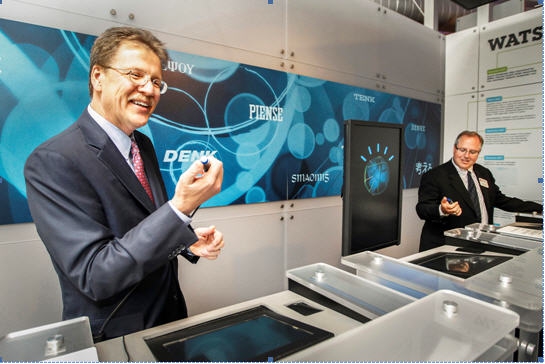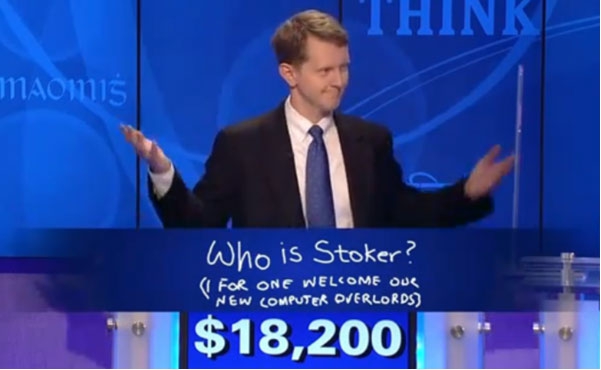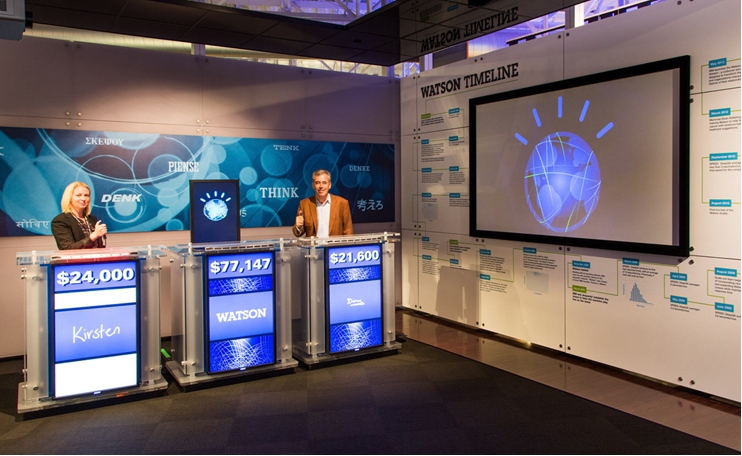

IBM Research Director Dr. John Kelly (left) with CHM CEO John Hollar “buzz in” to the Jeopardy! set. Credit: Associated Press
Tuesday night (June 10, 2013) at the Computer History Museum, IBM senior vice president and director of IBM Research Dr. John Kelly formally presented part of the IBM Watson Jeopardy! stage set to CHM CEO John Hollar.
The custom-designed television stage set is part of an informative and entertaining temporary exhibit on the Watson system, its remarkable recent performance on Jeopardy!, and IBM’s plans for using Watson technology in future computing systems.
Jeopardy!, if you’ve been living in a cave since 1964, when it first broadcast, is one of the longest running television game shows in history. It’s probably also the only game show where some actual intelligence beyond the man-in-the-street variety is required to play and to win. Quite a bit of intelligence, as it turns out.
In Watson’s case, being good enough to beat human players at a game of subtle intellectual nuance—based on clues rife with cultural references, double meanings and nasty puns–really stretched the boundaries of computing in a number of areas, including natural language understanding, data analytics, and so-called “Deep QA” (Question Answering) technology. It took 7 years of research and development but IBM’s Watson has become a cultural milestone we won’t soon forget. Over 34 million Americans watched the two-day match—that’s over 10% of the U.S. population—and in the end, Watson emerged the winner, claiming the $1 million first place prize to be donated to charity.

All time Jeopardy! winner Ken Jennings, with a message to Watson.
Tuesday night (June 10, 2013) at the Computer History Museum, IBM senior vice president and director of IBM Research Dr. John Kelly formally presented part of the IBM Watson Jeopardy! stage set to CHM CEO John Hollar.
The custom-designed television stage set is part of an informative and entertaining temporary exhibit on the Watson system, its remarkable recent performance on Jeopardy!, and IBM’s plans for using Watson technology in future computing systems.
Jeopardy!, if you’ve been living in a cave since 1964, when it first broadcast, is one of the longest running television game shows in history. It’s probably also the only game show where some actual intelligence beyond the man-in-the-street variety is required to play and to win. Quite a bit of intelligence, as it turns out.
In Watson’s case, being good enough to beat human players at a game of subtle intellectual nuance—based on clues rife with cultural references, double meanings and nasty puns–really stretched the boundaries of computing in a number of areas, including natural language understanding, data analytics, and so-called “Deep QA” (Question Answering) technology. It took 7 years of research and development but IBM’s Watson has become a cultural milestone we won’t soon forget. Over 34 million Americans watched the two-day match—that’s over 10% of the U.S. population—and in the end, Watson emerged the winner, claiming the $1 million first place prize to be donated to charity.

CHM’s new Watson Jeopardy! exhibit.
The full-size original Jeopardy! stage set took up a large auditorium at the T.J. Watson Research Center in Yorktown Heights, N.Y. (The similarity in names is no coincidence: both research center and Jeopardy! computer system are named after T.J. Watson, IBM’s original founder and chairman… and his son—also named T.J. Watson). Because of its size, the giant category display (made up of 36 giant television monitors), is not part of CHM’s exhibit.
But those famous podiums, complete with buzzer and screen you can write your name with, are there. As is the mysterious and enigmatic Watson avatar, pulsing gently in the background. There’s also a wall-size timeline of Watson development, four short movies about Watson and what it can do, and an interactive kiosk where you can try your hand at playing Jeopardy! against a simulated Watson. (Watson’s brains are contained in 8 refrigerator-sized cabinets in New York and are currently being used on other projects).
Where did the idea to spend millions of dollars on a project to win on at television game show come from? In the fall of 2004, IBM’s head of computing systems software, Charles Lickel, was meeting his software team in Poughkeepsie, New York, at a nearby steakhouse. They were surprised when, exactly at 7:00, the restaurant turned quiet as everyone began paying attention to the Jeopardy! match on television. A mild-mannered software engineer named Ken Jennings was defeating all comers in a virtuoso performance—any category, any era, any historical event or person—he was unstoppable until he finally lost after a ridiculous 74 games.
Some months later, while tasked with setting new research directions by then IBM Research director Paul Horn, Lickel suggested that building a computer that could compete on Jeopardy! would demonstrate IBM’s technical capabilities in an entertaining and impressive way (if it won).
Over the next seven years, a core team of about thirty people, led by Dr. David Ferrucci, worked crazy hours to bring Watson up to a point where it could begin to hold its own against even bad players. In the early days, it definitely had teething problems. Even in the final match, Watson could occasionally lose its mind: In the category of U.S. Cities, for example, it answered “Toronto.” (Of course, there are U.S. cities named Toronto… but it was not the intended, or correct, answer).
Watson is a philosophy as much as a computer system, an approach and model of the world as well as a physical computing platform. IBM has big plans for Watson-style technology in the future. Watson is part of the IBM ‘smarter planet’ initiative, in which computing systems must adapt from being machines that are programmed to machines that can learn themselves and which can act upon and respond to a world full of data from sensors, databases, &c.
Not only is the amount of data produced in our world staggering (2.5 quintillion bytes/day—that’s 1 with 18 zeroes after it), there are not enough computer programmers in the world to write the software to deal with it. Some type of machine intelligence, always ultimately guided by humans, must be applied to find the small fraction of usable data from the torrent of information.
Hence Watson, a system that can guide a domain expert (like a doctor, a car mechanic or call center clerk) into making better, more accurate, decisions by itself asking questions of the user. Watson, for example, can inform a cancer doctor that certain test results indicate certain conditions, a fact the doctor already knows… but that a recent article in the New England Journal of Medicine proposes a radical new therapy that has shown great success. Unless the doctor it up on her reading, there’s a good chance she won’t know about the new treatment, in which case Watson’s advice could be lifesaving. This is what Watson is good at: sifting through terabytes of structured or unstructured data looking for patterns of meaning very quickly.
So is humanity in trouble? Not for a while yet. For one thing, while Watson is most impressive in the Jeopardy! context, its development potential is really in the very early stages. Currently, Watson is being used in test-bed scenarios in a small number of important industries, including healthcare and finance. It will be a while yet before the process of mutual alignment between user and machine in these industries is fulfilled and Watson’s true value realized.
We humans like to think of ourselves as special mainly because of our intelligence. It is probably our defining characteristic as a species. I think this is why watching a computer like Watson compete against two very smart humans is so compelling—the machine appears to have mastered at least part of what humans think makes them unique.
Whatever your thoughts on Watson, we hope you will come to the Museum and visit the Watson Jeopardy! exhibit and create a new memory!